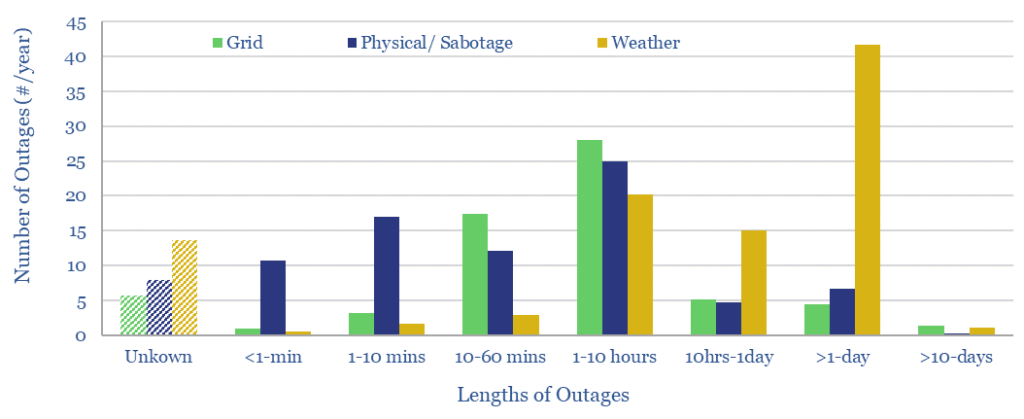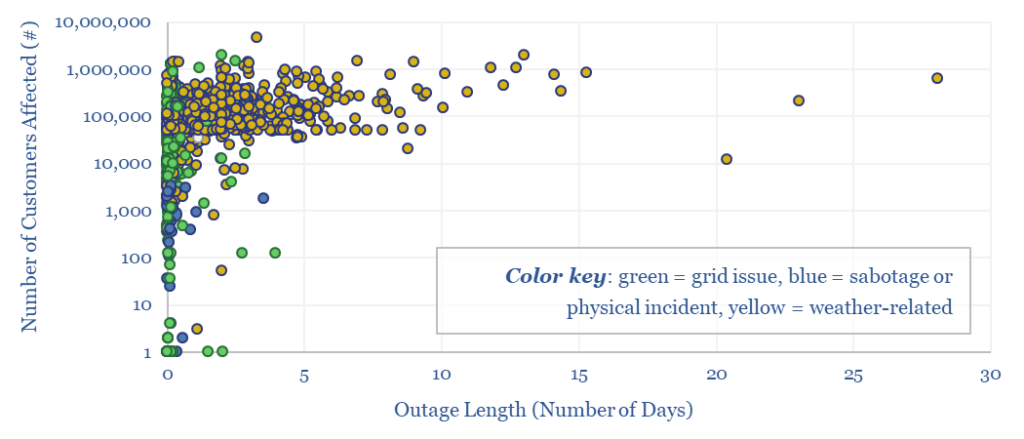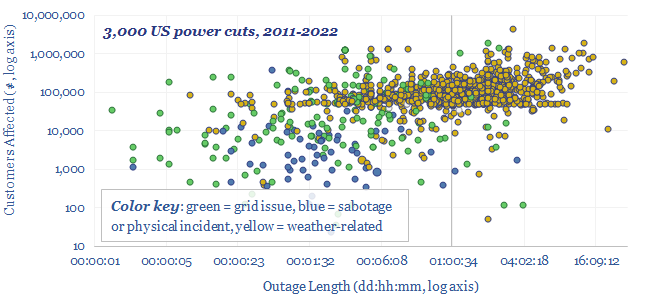This data-file aggregates significant US power grid disruptions, based on data from the DOE. On average, there are 250 power cuts per year in the United States, lasting for a median average of 5-hours, and affecting a median average of 80,000 customers. 20% of the power cuts last longer than 1-day. 15% affect more than 1M customers. What implications?
Power grids are a wonder of the modern world, and crucial enabler of the energy transition (TSE overview here). But how reliable are power grids? To answer this question, we have aggregated and cleaned-up data into 3,000 significant power disruptions, from the US Department of Energy.
How frequent are power cuts? The United States incurs an average of 250 power cuts per year, each impacting an average of 80,000 customers, for an average of 5-hours. Note that a “customer” can range from a studio apartment to a 400-bed hospital, but our guess from the data is that c20% of the US population endures a serious power cut each year.

What are the causes of power cuts? Over the past decade, 40% of US power cuts can primarily be attributed to weather events, such as storms or heatwaves, 35% can be attributed to physical incidents, vandalism or sabotage, and 25% can be attributed to failure of grid infrastructure itself.

Different outages have different characteristics. The median sabotage event impacts 2,000 customers and is remedied within 1-hour. The median average grid failure impacts 20,000 customers and is remedied within 2-hours. The median average weather issue impacts 90,000 customers and is remedied within 1-day.

The worst power cuts can occur in the aftermath of major weather events such as hurricanes, leaving “millions” of customers without power for 5-30 days. The database contains 27 power cuts (i.e., >2 per year) that impact more than 1M customers, and 97 that last longer than 5-days (i.e., 8 per year). The impacts of such power cuts have been poignantly dramatized in Apple TV’s recent series Five Days at Memorial.

Seasonality also contributes. There are 30% more disruptions than average in August, which is prone to heatwaves and hurricanes, and 13% more than average in February, which is prone to winter storms. Conversely, there are 30% fewer disruptions than average in November, amidst mild autumn weather.

Are US power cuts becoming increasingly prevalent? The DOE’s power grid disruption database saw a trough of 141 incidents in 2016, rising to a new peak of 390 incidents in 2022. This is all the more remarkable because 2022 was a year with fewer weather-related disruptions than average.

What is causing the uptick in power grid disruptions? Grid disruptions attributed to the grid itself (i.e., not directly caused by weather or physical incidents) have increased from 36 incidents per year in 2012-17 through to 125 per year in 2020-22 (below).
Implications? This suggests increasing investment is needed in power grid infrastructure, and possible upside for transmission utilities and companies constructing power transmission. It may also create rising demand for backup solutions, from batteries to CHPs to diesel generators. Finally it illustrates the need for smart grid and power electronics technologies.
Our cleaned-up interpretation of the raw data, some analytics, averages, and charts are available in the data-file. The data-file has been updated for 2023 data in March-2024. Our best ideas in power grids are linked here.
